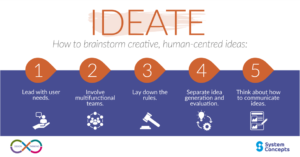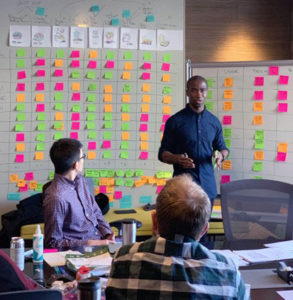Well would you look at that! We have officially reached the halfway point of our series Zero to One. I wanted to start this week’s post off with a moment to celebrate the product journey thus far. If you’ve been with us from week one, we started off by introducing the UX process, followed by understanding your users and their challenges. We emphasized building with the end user in mind, so now that you’ve done your due diligence and research, it’s time for the magic to start… well, almost.
One of the biggest takeaways from last week’s post was thinking and building with the end user in mind to obtain the best insight for user experience. One might ask, “so where do we start? How do we even begin to start the brainstorming process?”
Generally, I’ve seen this lumped together as one single step. However, in my experience and for the sake of this post I figured it would make more sense if I broke it into two steps, generating and deciding the ideas. Also, a quick look ahead on how to test those ideas.
With that being said, let’s get into how you or your team should approach the ideation phase of the product journey.
“Eureka” Creating the idea.
Before we dive into the ideation phase, I wanted to briefly circle back again to last week’s topic of empathize and define (told you this was going to be non-linear) and specifically the define portion. Now if you remember, in the defining phase the biggest takeaway was to understand your “XYZ” or better known as your “who, what, and why” because, after all, who are we building for? You guessed it, the user.
Keeping that in mind, now that you and your team are challenged with the next steps, how to brainstorm on how to generate solutions that solve real user problems.

Best practices
“How might we” questions
After you and your team have taken time to have a thorough discovery of your user, it’s important to refer back to your research, because from this point is where we want to start brainstorming some theoretical, or How might we (HMW), questions. A How might we question can help frame your ideation so that you and your team can begin exploring new ways to solve the problems at hand.
I’ll be using Swipabot once more as a project example. A couple of examples of HMW questions I used were:
- How might we create a simple-to-use desktop app for non-technical users?
- How might we add a feature for users who wish to repeat the same task from a previous session?
- How might we offer a different user experience for both of our user personas?
“Bad” ideas are welcomed
Growing up, I’m sure you’ve heard the old saying, “there’s no such thing as a stupid question” well this holds true in the world of design and UX, sort of.
Working with a team isn’t always the smoothest sailing when it comes to trying to democratize people’s insights and ideas. While this second part of the ideation phase is one that can be the most challenging, there are civil and efficient ways to decide on the most relevant ideas moving forward.
Best practices
- Four Categories Method
- Now Wow How
- Dotmocracy
I could spend an entire post breaking down each activity in detail and how to get the best out of it, but for now I’ll briefly highlight one of my personal favorite methods, dotmocracy.
Dotmocracy is a method centered around prioritization, and best performed with more people on your team. The group collects ideas via post-it or sticky notes. Those notes are stuck on a wall or board, and from there the options are voted for and ranked to determine democratically which ideas move forward.

This is by no means is a perfect method and, just like with anything else, it’s important to do your own research and figure out the optimal process for you and your team. But I’ve found this exercise both fun and super impactful as you look to finalize and decide on which ideas should be put in motion.
Conclusion
Coming up with, and being decisive on, ideas is easier said than done. No one said this would be something you will be able to do in a day or two. I’ve found that generating the best ideas comes down to not limiting your and your team’s imagination, because sometimes those “bad” ideas are the ones that find the most success.
Looking ahead
Next week we’ll do things a bit differently, so take the time to get caught up on the previous posts as we gear up for the first ever Zero to One: Prototyping Workshop. Details will be dropping soon, so be on the lookout for a recap from me of the journey thus far.
As always, catch me this Tuesday on LinkedIn Live at 3pm EST and on Thursday on Twitter Spaces at 7pm EST to talk more about this week’s topic, see you there!






